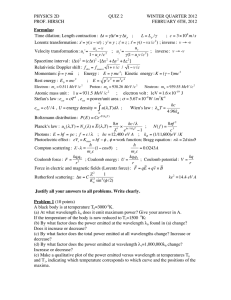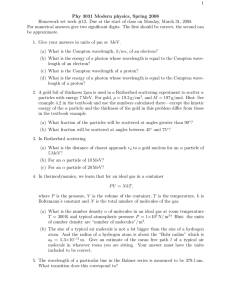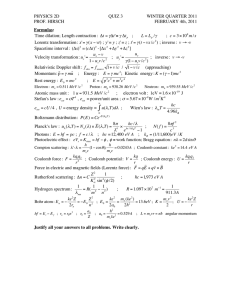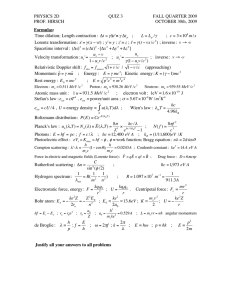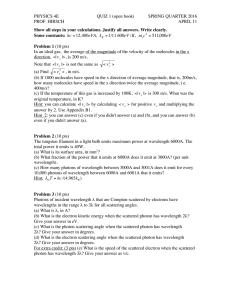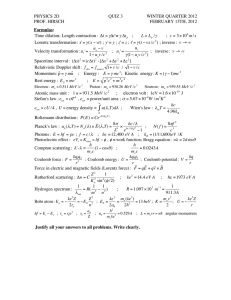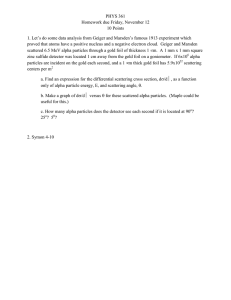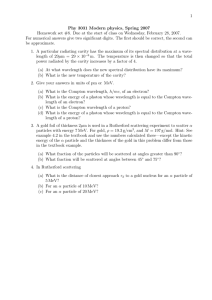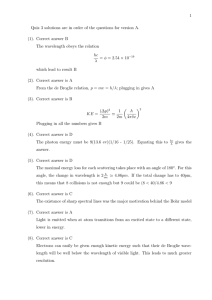PHYSICS 2D QUIZ 2 WINTER QUARTER 2016 PROF. HIRSCH
advertisement
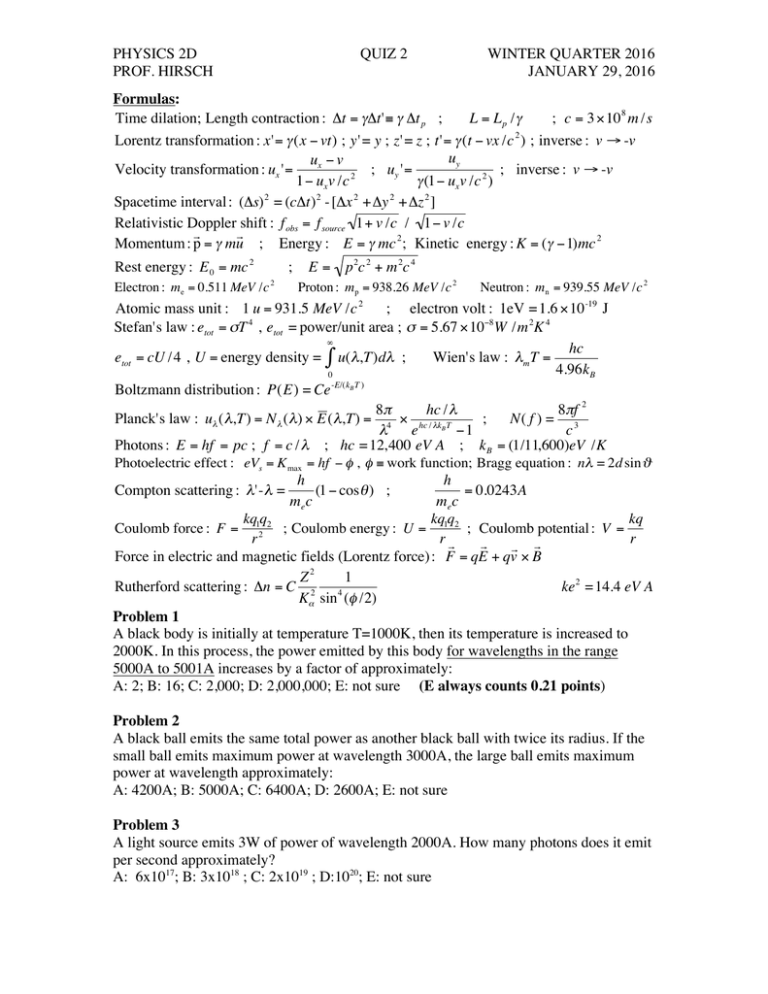
PHYSICS 2D PROF. HIRSCH € € € € € € € € € € € € € € € € € € € QUIZ 2 WINTER QUARTER 2016 JANUARY 29, 2016 Formulas: Time dilation; Length contraction : Δt = γΔt'≡ γ Δt p ; L = Lp /γ ; c = 3 ×10 8 m /s Lorentz transformation : x'= γ (x − vt) ; y' = y ; z' = z ; t'= γ (t − vx /c 2 ) ; inverse : v → -v uy ux − v Velocity transformation : ux '= ; uy '= ; inverse : v → -v 2 1− ux v /c γ (1− ux v /c 2 ) Spacetime interval : (Δs) 2 = (cΔt) 2 - [Δx 2 + Δy 2 + Δz 2 ] Relativistic Doppler shift : f obs = f source 1+ v /c / 1− v /c r r Momentum : p = γ mu ; Energy : E = γ mc 2 ; Kinetic energy : K = (γ −1)mc 2 Rest energy : E 0 = mc 2 Electron : me = 0.511 MeV /c 2 ; E= p 2c 2 + m 2c 4 Proton : mp = 938.26 MeV /c 2 Neutron : mn = 939.55 MeV /c 2 Atomic mass unit : 1 u = 931.5 MeV /c 2 ; electron volt : 1eV = 1.6 ×10 -19 J 4 Stefan's law : etot = σT , etot = power/unit area ; σ = 5.67 ×10−8 W /m 2K 4 ∞ hc etot = cU /4 , U = energy density = ∫ u( λ,T)dλ ; Wien's law : λm T = 4.96kB 0 -E/(kB T ) Boltzmann distribution : P(E) = Ce 8π hc / λ 8πf 2 Planck's law : uλ ( λ,T) = N λ ( λ) × E ( λ,T) = 4 × hc / λkB T ; N( f ) = 3 λ e −1 c Photons : E = hf = pc ; f = c / λ ; hc = 12,400 eV A ; k B = (1/11,600)eV /K Photoelectric effect : eVs = K max = hf − φ , φ ≡ work function; Bragg equation : nλ = 2d sin ϑ h = 0.0243A mec kq q kq q kq Coulomb force : F = 12 2 ; Coulomb energy : U = 1 2 ; Coulomb potential : V = r rr r r r r Force in electric and magnetic fields (Lorentz force) : F = qE + qv × B Z2 1 Rutherford scattering : Δn = C 2 ke 2 = 14.4 eV A 4 Kα sin (φ /2) Problem 1 A black body is initially at temperature T=1000K, then its temperature is increased to 2000K. In this process, the power emitted by this body for wavelengths in the range 5000A to 5001A increases by a factor of approximately: A: 2; B: 16; C: 2,000; D: 2,000,000; E: not sure (E always counts 0.21 points) Compton scattering : λ'- λ = h (1 − cos θ ) ; mec Problem 2 A black ball emits the same total power as another black ball with twice its radius. If the small ball emits maximum power at wavelength 3000A, the large ball emits maximum power at wavelength approximately: A: 4200A; B: 5000A; C: 6400A; D: 2600A; E: not sure Problem 3 A light source emits 3W of power of wavelength 2000A. How many photons does it emit per second approximately? A: 6x1017; B: 3x1018 ; C: 2x1019 ; D:1020; E: not sure PHYSICS 2D PROF. HIRSCH QUIZ 2 WINTER QUARTER 2016 JANUARY 29, 2016 Problem 4 A light source of wavelength 5000A shining on a metal surface produces no photoelectrons. However if this light source is moving and approaching the metal at speed 1/2 of the speed of light, photoelectrons of maximum kinetic energy 1eV are detected. What is approximately the work function of this metal? A: 1.5eV; B; 3.3eV C: 2,8eV; D: 3.6eV; E: not sure Problem 5 In a Compton scattering experiment with a monochromatic X-ray source, photons scattered at angle 30o relative to the direction of incidence have wavelength 1A. What is approximately the kinetic energy of the scattered electron? A: 200eV; B: 233eV; C: 266eV; D: 300eV; E: not sure Problem 6 The charge to mass ratio for an electron is 1.76x1011 C/kg. In a Thomson vacuum tube the applied electric field of 100 V/cm between parallel plates of length ℓ =4cm deflects electrons as they enter the space between the plates traveling in direction parallel to the plates at a speed 2x107m/s. The angle at which the electrons are deflected relative to the incident direction when they emerge from the region between the plates is approximately, in radians: A: 0.170; B: 0.172; C: 0.174; D: 0.176; E: not sure Problem 7 In a Rutherford scattering experiment with a metal foil with atoms of atomic number Z=20 and using 8MeV α particles the Rutherford law given in the list of formulas is found to be satisfied for all angles. What can you say about the radius of this nucleus, R? (1fm=10-5A) A: R<7.2fm; B: R>7.2fm; C: R>3.6fm; D: R<3.6fm; E: not sure Problem 8 For the Rutherford scattering experiment of problem 7 suppose the energy of the α particles is now increased to 10MeV, and it is found that for every 1600 particles scattered at 60o angle there are 400 particles scattered at 90o angle. How many particles are scattered at 180o angle for every 1600 particles scattered at 60o angle? A: 100; B: 100 or more than 100; C: 100 or less than 100; D: impossible to say; E: not sure

